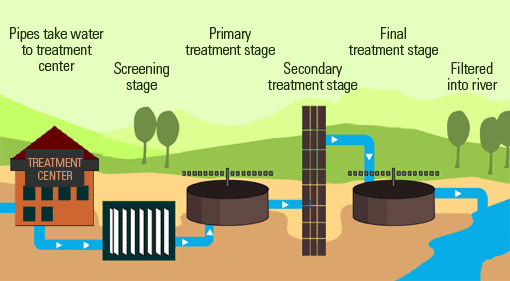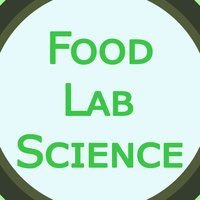Toilet to tap
Did you ever think about how your wastewater is dealt with? Often it goes through a process of filtering and sludge removal until it is clean enough to be drained into a river (Figure 1). In the U.S. it is common to use clean drinkable water in an all-purpose kind of way. Water is pumped from natural sources and goes through purification processes. Afterwards, that water is used for drinking, cooking, flushing, and showering. All this water is collected, goes through cleaning steps, and can subsequently be used for replenishing ecosystems, irrigation, industry, and toilet flushing.

Figure 1: Treatment of waste water.1
It is starting to become more common to recycle water for the purpose of drinking and cooking. This means that the water that went through your toilet ends up back in your tap water. With all the shampoo, food residue, and excrements inside the wastewater, it better be clean!
From waste to water
Converted sewage water is called reclaimed water. To purify the water so that it is drinkable it has to go through several treatment steps.
Screening
First, the sewage has to be rid of solid particles. The easiest way is to feed the sewage through a filter system that separates solids from the liquid. However, this process of screening only takes out the large solids that are present. Further solids filtering is required, which is done in the first treatment step.
Treatment 1
In the first treatment step the filtered sewage is transported to sedimentation tanks where smaller solids sink to the bottom (sludge), and oil and grease float to the top (scum). The sludge is usually scraped to the middle of the tank where they have sucked away. Afterwards, the water is drained and separated from the oily scum. The water is transported for secondary treatment.
Treatment 2
In the second treatment step, the feed of water arrives in large rectangular tanks, which are called aeration lanes. Bacteria are added to the tanks and air is pumped into the water. The aim is to encourage bacteria to break down the sludge that remains. The remaining sludge is often organic solids, such as small pieces of wood, plastic or other carbon-based compounds.
Now the solids that were originally present have been sufficiently removed. Except the bacteria that have been added have grown and need to be removed, which happens in treatment 3.
For more information on this bacterial cleaning. I wrote a post on bioremediation yesterday.
Treatment 3
To remove the bacteria the water is transported to settlement tanks. The bacterial mass sediments and again a sludge is formed at the bottom. This sludge is also scraped away and pumped out of the tank. The water is then forced through a layer of sand, which acts as a natural filter for any particles missed by the previous treatments. The water can now be released into a river. For industry and irrigation, the water is also chlorinated and salt is removed.

Reclaimed water treatment
To turn river-safe water into reclaimed water some more treatment is required. A more advanced treatment is done that starts with microfiltration. Microfiltration uses membranes with a pore size of 0.1 – 10 μm. This is small enough to remove bacteria or any other leftover small solids, however, it does not block all viruses. These viruses should still be removed though, we don’t want to get sick from viruses in our drinking water. To achieve this Reverse Osmosis (RO) is applied. Osmosis is the spontaneous process of water moving from a less saline fluid to a more saline fluid. RO is the reverse of osmosis (who would’ve guessed) and costs energy. It is done by applying a high pressure to the water so that it can pass through a membrane that is small enough to filter out viruses and pharmaceuticals. Any leftover bacteria or protozoa not removed by the microfiltration step are also removed here. A final treatment is a disinfection with ultraviolet light, ozone, or hydrogen peroxide.
Now the water is safe for drinking. Except the public doesn’t trust the toilet water at all, so to appease them the water is stored in groundwater or surface water for a period of roughly 6 months. It’s clean now, really, not much more we can do!
Where do they drink reclaimed water?
- Australia: A country often suffering droughts. They are actively looking into using large amounts of reclaimed water. Smaller projects on reclaimed water are done, especially in Brisbane.
- Israel: Since 2010 Isreal is the world leader in reclaimed water. They reuse 80% of total sewage, very impressive!
- Namibia: Reclaimed water has been used for over 40 years in the capital Windhoek. The city uses about 14% of reclaimed water for their drinking water.
- Singapore: This country branded reclaimed water NEWater. They originally sold it as bottled water but are now using it for 30% of their total drinking water. Their goal is to crank this up to 50% of total drinking water by 2060.
- South Africa: This is also a dry country and has led them to look into reclaimed water for similar reasons as Australia. They have achieved to exchange a third of their total drinking water with reclaimed water.
- U.S.: In the U.S. Florida and California are the leading states concerning reclaimed water. For example, in southern California in a place called Orange County there is a large-scale plant where water is processed to reclaimed water. This plant is also a typical example where it is not necessary to put the water coming from the plant back into the ground. It is done mostly to prevent public fear.
Now here is the real question. Would you drink reclaimed water?

References:
Drinking Water from Wastewater
Liquid Waste (Sewage/Wastewater) Treatment
From Wastewater to Drinking Water
Reclaimed water
Septic System
Recycling sewage in Namibia
Micro filtration
Organic solids
Reverse Osmosis
Images:
Unsplash
Related from @Altherion
Bioremediation: Living Cleaners
A Case for the Moon Base
Legumes: A comprehensive processing overview
The Nano World – Atomic Layer Deposition
Survival of the Fattest
by FoodLabScience
Twitter

A scientist’s food for thought!
You should have titled it "From Crap To Tap" :P
You know it's funny, because this water might actually be safer than common tap water, but it's the idea of how it has been used that puts people off. I don't know if I would drink it, at least not without being assured that it's completely healthy.
Good one! I totally missed out on that one.
You're correct it's the idea. Similar to people in Asia eating insects often but the Western world is almost repulsed by the idea of it.
Hello @altherion,
How are you doing?
I'm good @yaanivapeji, how are you doing in 2018?
Pretty much good. Thank you.
Good post. It is the common problem of under developed countries. There is not proper way of disposal of waste water mainly the sewerage system is not good. The sewerage adult water is directly drained to rivers. So there is increase of diseases . So its good awareness for the peoples. Thanks for sharing.
Thanks @thedawn. It's quite a big problem I agree. Something Europe had in the Middle Ages. If you lived downstream you'd have dirty water since cities upstream would pollute the water. It's about time underdeveloped countries get clean water, and it all starts with awareness.